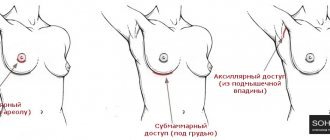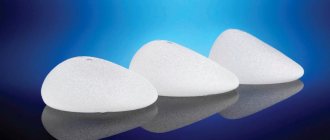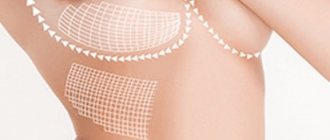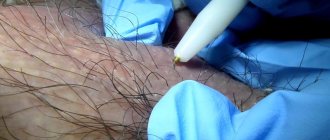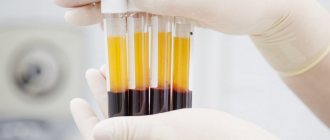But special attention is paid to the female breast, which is deservedly and rightly perceived as the main indicator of femininity and sexuality. Therefore, mammoplasty is the most popular - breast surgery, which is performed in order to achieve the best aesthetic effect and a satisfactory result for the woman.
Representatives of the fair sex are quite concerned about such a problem as prolapse (ptosis) of the mammary glands. With ptosis, the breasts lose their attractive shape, become flat, unvoluminous and saggy. To eliminate this defect, a breast lift is performed. And one of its varieties is T-shaped mastopexy, which is called anchor. This article discusses questions related to this operation and answers to them, as well as useful information on the topic of breast surgery.
What is anchor mastopexy?
What does anchor breast lift mean?
This operation received this name because the remaining scars in their shape resemble an anchor or the letter T, only upside down. Postoperative scars are usually located along the line of the inframammary (inframammary) fold, along the lower edge of the areola (or around the entire nipple-areola complex, including in the upper zone), as well as vertically from the nipple with the areola to the inframammary fold.
In plastic surgery, there are other methods of performing mastopexy, namely:
- Periareolar. The suture is formed only around the areola with the nipple, but this method is suitable only for not too pronounced ptosis (first degree or pseudoptosis).
- Vertical. The incision for this type of lift is made vertically: from the areola downwards to the very submammary fold. Sometimes an access is also formed through the semicircle of the areola (around the nipple-areolar complex).
When performing an anchor breast lift, the doctor first draws up an operation plan and marking diagram in order to, taking into account the individual characteristics of a particular patient, select the best option that will help eliminate existing defects. Many surgeons combine different incisions:
- Circular (circular) along the contour of the areola. It allows you to raise the nipple-areolar complex higher, as well as correct its shape in case of excessive stretching or asymmetry.
- Vertical. As a rule, two such incisions are made so that it is possible to remove the flap of skin formed between these lines.
- Horizontal, located in the submammary region. A whole flap of skin is also excised in this area.
After forming all such incisions and connecting all the edges, only thin seams remain: around the areola with the nipple, vertical from the edge of the areola to the inframammary fold and under the breast at the fold line.
When performing mastopexy using the anchor technique, several problems are solved at once: the mammary gland itself is raised to the natural anatomical level, the position and sometimes the shape of the nipple and areola are changed (if they are drooping and deformed), the mammary glands are either reduced or enlarged with the installation of implants in them.
Sometimes, with an anchor lift, reduction (smaller) plastic surgery or breast augmentation using implants is performed simultaneously. In the first case, the doctor performs a reduction when the volume of the mammary gland is very large, and the woman wants to achieve a smaller, more miniature size. In this case, the specialist removes not only excess skin, but also excess soft tissue. Enlargement surgery with implants is carried out at the request of a woman if her breasts, on the contrary, are small.
For your information!
In addition to implants, another technique is also used for breast enlargement - lipofilling. This is actually a transplantation of the patient’s own fat tissue into the mammary glands, borrowed from bulky parts of the body and subjected to special purification. But this method of correction is considered less effective than installing implants, since fat can be absorbed, and the result of an increase in one session usually does not exceed 1-1.5 sizes.
Breast enlargement techniques
Implants (prostheses) are placed in the breast through various approaches:
- Periareolar. The incisions are formed along the contours of the areolas. But this method is suitable for sufficiently sized areolar zones and not very large implants. The advantages include that the scars remain less noticeable, and the surgeon can simultaneously correct the altered nipple-areolar complex. But with surgical intervention on the areola, partial or complete loss of sensitivity in the nipple and problems during the establishment of lactation (due to damage to the milk ducts) are likely. Over time, sensitivity in the nipples and areolas may return.
- Submammary. Access is formed along the contour of the inframammary fold, that is, under the breast. With this approach, the surgeon has the best view, and the likelihood of damaging the milk ducts is low. But with weakly defined mammary glands, scars may be too noticeable.
- Axillary. The surgeon makes an incision in the armpit area, where the postoperative scar will be located.
Helpful information!
Implants are installed either above the pectoral muscle under the gland, or under the muscle, or in a two-plane manner (under the glandular tissue and partially under the muscle).
Why surgeons choose an anchor breast lift
The decision in favor of one or another method of mastopexy is made by the surgeon who will perform the operation. Already at the stage of the first consultation, he carefully evaluates the initial data: the condition of the skin (elasticity, degree of stretching, density), the existing shape of the breast and its volume. The doctor also takes into account the general health of the patient and her age. So, the older a woman is, the thinner and less elastic her skin is. And in young girls, hormonal fluctuations are possible that affect breast size and its changes in certain periods of life, for example, during pregnancy and after childbirth during lactation.
Undoubtedly, for any patient the ideal option would be a lift with a minimum amount of scars, but it is not always possible. For first-degree ptosis, the problem can be solved by mastopexy; for second-degree ptosis, a vertical technique is recommended. But if the ptosis is severe, already in the third stage, then the most effective way to solve the problem will be an anchor lift of the female breast.
The T-shaped technique allows you to get beautiful, attractive, firm and lifted breasts even in particularly difficult situations:
- with excessive amounts of stretched skin;
- with enlargement or deformation of the breast areolas;
- with an asymmetrical shape of the nipple-areolar complex or the entire mammary gland;
- when the elasticity of the breast skin decreases;
- with excess volumes of soft tissue;
- if there is insufficient tissue volume (then breast augmentation with implants is recommended).
How does a vertical lift differ from other techniques, why is it better?
Why do plastic surgeons often choose vertical mastopexy?
A female patient may ask the doctor to do without a vertical incision on the chest, and such requests are often driven by fear of the formation of rough scars. But, firstly, the scar with a competently performed operation is hardly noticeable. Secondly, without a full breast lift, the results may differ greatly from those expected or stated by the doctor.
Why may the results of the operation ultimately not be the best?
If a significant amount of excess tissue is removed, then with a circular mastopexy with an incision around the areola and nipple, the skin may be subject to severe stretching, and this, in turn, provokes severe scarring. The woman is left with noticeable scars, which cause discomfort and cause complexes.
In addition, without a vertical incision when creating only a periareolar approach, the breast after a lift may become insufficiently round, that is, somewhat flattened.
Performing anchor mastopexy: pros and cons
Like any other operation, the anchor lift has its positive and negative sides. Benefits include:
- elimination during plastic surgery of even very pronounced, significant mastoptosis;
- the possibility of correcting the shape of the nipple-areolar complex of the breast;
- elimination of the asymmetry that has arisen.
The disadvantages are:
- the operation is quite traumatic;
- more noticeable scars on the chest;
- long rehabilitation period (usually longer than after mastopexy).
When is anchor mastopexy indicated?
Indications for prescribing a woman an anchor lift of her breasts include, first of all, mastoptosis, and of the third degree, in which the nipple and areola fall below the inframammary fold by more than 2-3 centimeters. Also, in parallel, a woman may wish to undergo a bust enlargement if its volume is insufficient, or, conversely, a reduction if the amount of soft tissue is excessive.
Significant breast ptosis can occur for various reasons: due to inevitable age-related changes, due to feeding, pregnancy and childbirth, due to hormonal imbalances, as well as sudden changes in weight.
A separate case is repeated anchor lifting. It is prescribed if the first plastic surgery led to difficulties, the woman was not satisfied with the aesthetic result, or prolapse occurred due to age-related or other changes in the female body or due to her failure to comply with the doctor’s instructions.
Changing the shape of the breast using a gel based on stabilized hyaluronic acid
Many people are familiar with contour plastic surgery - nasolabial folds and wrinkles are filled using injections with a gel based on stabilized hyaluronic acid of non-animal origin.
In the same way, you can improve the shape of your breasts and correct asymmetry. True, the volume of the injected gel, of course, will be much greater than in the case of wrinkle correction. Similar gels from different manufacturers to change the shape of the breast are successfully used in Japan and European countries. It has a minimal number of contraindications - autoimmune diseases, allergies to hyaluronic acid, skin infections, pregnancy and lactation - and does not affect the body's life support systems. Despite the apparent ease of this procedure, it is preceded by tests and examination, just like before a surgical operation. The minimally invasive procedure is usually performed under local anesthesia and lasts about an hour. The gel is injected through several punctures with a thin needle, traces of which disappear after a few days. You can go home almost immediately after the procedure, and the final result of changing the shape of the breast is visible after the swelling subsides. At first you will have to wear compression garments, which you need to purchase in advance. Many people call changing the shape of the breast using gel an alternative to endoprosthetics. But this is only true regarding the price - the cost of 300 ml of gel ranges from 4 to 6 thousand euros. While the gel does not remain for a long time - its resorption period ranges from 6 months to 2 years, then the procedure can be repeated. Such a long-lasting effect compared to gels used for facial contouring is due to the different density of the gel and resorption time. If obvious asymmetry has formed after a breast lift, the gel can be dissolved within 24 hours with a drug called hyaluronidase.
But it is worth mentioning possible side effects - chest pain, gel migration, uneven or premature resorption. In addition, there is insufficient data on the long-term effects of injecting this amount of gel into this area. The drug may also interfere with breast examination, which prevents the recognition of tumors in the early stages. In this regard, it is very important to take seriously the choice of a clinic and a doctor for the procedure. A high-level specialist will do everything possible to minimize possible risks during the operation.
When such surgery is not recommended*
Any operation has contraindications, and anchor breast lift is no exception. It is not carried out when:
- under 18 years of age;
- fibrocystic mastopathy, the presence of cysts in the mammary glands;
- serious cardiovascular diseases in the stages of decompensation;
- endocrine diseases such as diabetes;
- blood clotting disorders;
- serious systemic infectious diseases: hepatitis, HIV, syphilis;
- exacerbations of any chronic ailments;
- obesity;
- mental disorders;
- hypertension;
- pathologies accompanied by disruptions in the functioning of the immune system;
- acute respiratory diseases;
- pregnancy;
- the period of breastfeeding and for six months after its completion;
- planning pregnancy in the near future, etc.
*This article is for informational purposes only. You will receive detailed information during a consultation with your doctor.
Do I need to prepare for an anchored breast lift?
Such a correction requires preparation, which includes, first of all, a medical examination. The patient must undergo diagnostics, including various tests and procedures*:
- blood tests: general, coagulability (coagulogram) and biochemical;
- general urine analysis;
- blood tests for infections (hepatitis, HIV, syphilis);
- determination of Rh factor and blood group;
- fluorogram;
- Ultrasound of both mammary glands;
- ECG.
*This article is for informational purposes only. You will receive detailed information during a consultation with your doctor.
If necessary, you need to make appointments with specialized specialists: gynecologist, surgeon, oncologist, endocrinologist, phlebologist, cardiologist.
Also during the preparatory period some restrictions should be observed:
- For two weeks, stop taking medications that affect blood clotting: vitamin E, anticoagulants, non-steroidal anti-inflammatory drugs, oral contraceptives.
- In two or three weeks, give up cigarettes completely or reduce their number to a minimum, and also stop drinking alcohol.
- Maintain a stable weight or lose it if you are overweight.
- The day before the scheduled date of plastic surgery, take a bath or shower.
- Arrive on an empty stomach and stop drinking liquids, including water, 7-12 hours before the scheduled time of breast surgery.
The doctor must explain all the requirements during the consultation. The result of breast lift surgery largely depends on compliance with the recommendations. So, if a woman does not comply with them, she increases the risk of complications.
How does breast lift surgery work?
The first stage of an anchor breast lift is an initial consultation, during which the doctor must determine which technique to choose. If a T-shaped lift is indicated, then the doctor, taking into account the existing problems and the initial condition of the breast (shape, size, presence of asymmetry), draws up a surgical plan.
The entire operation of an anchor lift lasts, on average, from 2.5 to 3.5 hours, depending on its complexity and the manipulations performed (reduction with excision of excess soft tissue, augmentation with implants).
Usually, the woman spends the first 24 hours in hospital under medical supervision, and then, in the absence of unpleasant symptoms, she is discharged and sent home, but receives sick leave for 2-3 weeks, depending on the speed of recovery.
Recovery after correction
The duration of postoperative rehabilitation depends on the individual characteristics of the patient (body condition, health), the type and complexity of the operation performed, and the volume of interventions.
First, the operated patient is in the hospital. The length of his stay in the clinic depends on the speed of tissue healing and the dynamics of the body’s recovery after the operation.
Postoperative recovery includes compliance with the following rules and restrictions:
- For three to four weeks, lifting your arms and sleeping positions on your stomach and side are prohibited.
- From 1.5 to 3 months, the operated patient will wear supportive compression garments constantly and for another year - when performing physical exercises.
- After about three months, you can resume physical activity gradually and moderately. It is possible to play sports professionally approximately six months after breast correction, without putting stress on the upper shoulder girdle.
- For two months, the woman does not go to solariums and baths, to public reservoirs and swimming pools, as well as to beaches.
- You need to observe sexual rest for several weeks.
- You should visit your surgeon regularly to monitor the progress of healing and breast reconstruction*
*The most complete list of rehabilitation recommendations can be provided to you by your doctor during your consultation.
Features of rehabilitation*
Rehabilitation after an anchor lift of a female breast in the early period lasts about a month: during this time, possible hematomas resolve, bruises disappear, and the healing process occurs. In the first few days, pain may persist, which, on the recommendation of a doctor, can be relieved with painkillers. To prevent infection, a weekly course of antibiotic therapy may be prescribed.
After two weeks, you need to come to the clinic to evaluate the preliminary results of the plastic surgery. Several more scheduled appointments are also scheduled. On average, after six months, the breasts can already reach their final shape after correction. Within six to eight months, the scars lighten and become thinner, and traces of sutures become less noticeable. After 9-12 months, the bust becomes the same as it will be in subsequent years.
The rehabilitation period requires compliance with some simple rules:
- preventing water from entering the seams for 4-5 days;
- daily treatment of scars with antiseptics for the first one to two weeks;
- sleep only on your back for the first two weeks;
- refusal to raise arms for the first two weeks;
- limiting physical activity and avoiding heavy exercise for two to three months;
- refusal to visit solariums, ponds, bathhouses, beaches for a month or two;
- Wearing a compression bra constantly for 6-8 weeks, and for the next 6-8 months only before doing physical exercise.
All prescriptions are given by the doctor during the consultation.
*This article is for informational purposes only. You will receive detailed information during a consultation with your doctor.
Dressings and home care
Already on the operating table, the patient is put on special compression garments, which must be worn for 1 month.
After the procedure, the surgeon individually prescribes dressings. Typically 2-3 appointments may be scheduled within a week.
At home, you should treat yourself as carefully as possible and adhere to the following rehabilitation rules for a month:
- sleep on your back
- don't lift weights
- don't play sports
- do not smoke or drink alcohol
- wear compression garments day and night
- protect skin from sun for 3-4 months
- avoid stress, get proper rest
WE ALSO ADVISE YOU TO READ: Alternative methods of breast enlargement
Existing risks of complications*
Complications occur infrequently, and their list includes bleeding due to suture dehiscence in the first week after surgery, seromas, tissue necrosis, infection and suppuration, loss of nipple sensitivity, severe swelling, significant and prolonged pain, as well as lack of desired results, prolapse of the mammary glands or their asymmetry, etc. Some problems require immediate attention; repeated surgery may be required.
*This article is for informational purposes only. You will receive detailed information during a consultation with your doctor.
Photos "Before" and "After"
1 month after surgery without implants
See more “Before” and “After” photos
What is mastopexy?
Mastopexy is a complex of various surgical techniques, the purpose of which is to return the mammary gland to its shape, position on the chest (raise), and correct the shape of the areola. I perform 80% of mastopexy surgeries in combination with augmentation with implants. The combination of techniques gives amazing results!
How to make scars as invisible as possible
The issue of scars is especially relevant. Many people worry that after an anchor lift, even a successfully performed lift, rough and very noticeable scars will remain. But such scars rarely remain: with a tendency to form keloid scars or with incorrect sutures.
For most women, scars begin to lighten and become thinner after a few months. After just a year, they resemble light, barely noticeable stripes. But to make them as invisible as possible, it is recommended to follow the following rules:
- avoid tension on the seams, avoiding sudden and amplitude movements and heavy loads;
- use specialized products that promote scar resorption;
- use the achievements of modern cosmetology, for example, laser resurfacing;
- Avoid contact of dirty hands with fresh stitches, observe personal hygiene rules.
How to influence the results of T-shaped mastopexy
The results that can be achieved with breast correction using T-shaped mastopexy depend on a number of factors, including the condition of the skin, the degree of age-related changes, the initial shape and volume of the mammary glands, lifestyle, hormonal stability, and the actual state of health.
But it is possible to influence the final result of the operation by responsibly approaching the search for a doctor. When looking for a clinic, you need to pay attention to:
- Peculiarities. She must have a good reputation. It is worth reading the reviews; it is best if you find friends who have already used her services.
- A surgeon. It is mandatory to have a higher specialized education and a license to conduct relevant activities. Experience in the field of plastic surgery and skill level are important. You also need to make sure that the doctor specializes in the type of surgery that you need. Just as in the case of choosing a clinic, it is a good idea to go to the specialist who has successfully operated on someone you know.
- Specialist's portfolio. You can study client reviews, videos and photos before and after plastic surgery. You can view such information on thematic forums, as well as on special web resources, for example, on their official websites or on pages on social networks (VKontakte, Instagram).
- Technical equipment. It is important to find out whether it uses high-quality, modern equipment.
Price in Moscow
- How much does a breast lift cost in Moscow? The budget depends on the complexity of the upcoming mastopexy. During the consultation, the doctor determines the degree of ptosis and chooses the method of surgical intervention.
- The weighting factor is the time, how long the procedure lasts. If you have a T-shaped mastopexy, the surgeon will need more time to create a new, attractive shape. This procedure is one of the most expensive of the 3 aesthetic surgery options.
- The budget is largely influenced by the number of consumables used. For example, it is cheaper to do a breast lift if you do not need to install implants.
The surgeon will tell you the budget for surgical intervention in your case during a personal consultation.
| Breast plastic surgery (mammoplasty) | Price |
| Breast augmentation with anatomical implants | 230 000 |
| Breast augmentation with round implants | 200 000 |
| Repeated mammoplasty | 260 000 |
| Periareolar mastopexy with breast augmentation | 250 000 |
| Vertical mastopexy with breast augmentation | 280 000 |
| T-shaped mastopexy with breast augmentation | 300 000 |
| Vertical reduction mammoplasty | 200 000 |
| T-shaped reduction mammoplasty | 250 000 |
What is the price of an anchor breast lift
Also, the issue of cost is relevant for everyone. The cost of breast lift surgery using the anchor method consists of the following factors:
- fame, technical equipment, reputation of the clinic;
- level of qualifications, experience and portfolio of the doctor performing breast lifts and other operations;
- components of the offer (the price usually includes not only the doctor’s work, but also the services of an anesthesiologist and other medical personnel, drugs and consumables used, compression garments, and hospital stay);
- terms of the promotion, if any;
- initial breast condition and problems to be solved;
- the complexity of the plastic surgery performed on the breast (lift only, or plastic surgery with bust enlargement/reduction, with or without the use of implants).
Breast lift prices can vary by tens of thousands of rubles, which is confirmed by reviews. The issue of cost is decided by management, but the excessively low cost of plastic surgery should be alarming. It is better to check the price in a specific clinic shortly before the planned date of breast lift.
Approximate prices
| Clinic "Doctor Albrecht" | from |
| Initial consultation with a plastic surgeon | 1 000 ₽ |
| Repeated consultation with a plastic surgeon | 500 ₽ |
| Reduction mammoplasty 3 degrees of complexity | 120 000 ₽ |
| Mastopexy (breast lift) periareolar | 65 000 ₽ |
| Mastopexy (breast lift) circumvertical | 95 000 ₽ |
| Mastopexy (breast lift) T-shaped | 110 000 ₽ |
| Simultaneous breast augmentation with periareolar lift | 110 000 ₽ |
| One-stage breast augmentation with circumvertical lift | 140 000 ₽ |
| One-stage breast augmentation with T-shaped lift | 150 000 ₽ |
If you still have questions about breast lift, you can ask them during your consultation. Usually you can make an initial appointment by phone or leave your contact details and order a call back or email. Another option is to write to the chat or come in person. One way or another, if you decide to have a breast lift, then you need to approach the preparation for it responsibly.
How complicated is this operation?
Before deciding to have breast surgery, most women experience fears and doubts. The concern is how complex the plastic procedure is and the degree of pain afterwards.
In surgery there is no concept of simple interventions. But breast lift, compared to breast augmentation with implants, is considered more labor-intensive, both from a technical and creative point of view.
For the patient, the rehabilitation period after mastopexy without the use of implants is easier to tolerate. The presence of the implant is accompanied by a feeling of compression/expansion in the chest; due to the cutting of the pectoralis major muscle, the pain is more pronounced. According to my patients, already on the second day after pexy there was no need to take painkillers.
⇒


